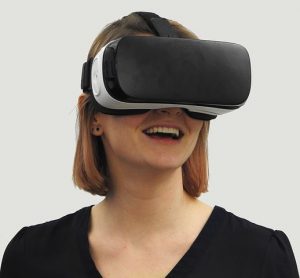
My Demo
It’s something I’ve been interested in for quite a long time so the chance to experience it first-hand was far too enticing to pass up. For those not yet aware of what Virtual Reality is, I’ll give you my layman’s explanation of it below.
When I put on the special helmet, my total vision was enclosed in a three-dimensional environment. I could look all around and see the different scenery, much like in real life. The motion felt incredibly real and my perception was fully absorbed in this new world. I had controllers in each hand which, when held in front of the visor, were shaped like hands, so it felt as if I could interact with the scenery. There was a total perception of space and depth so that even if the scenery was cartoony I still felt I was there, right in the middle of it.
Now, admittedly, in my wildest dreams I’d really like to experience something similar to the Star Trek’s Holodeck and whilst today’s available technology isn’t quite there yet, I still felt that the towering T-Rex was going to gobble me up for real when it came storming at me.
Gamers -v- Therapy
Avid gamers will already know the benefits and joys of immersion whilst enjoying computer gaming but my real interest is whether Virtual Reality can help in the therapy room and in particular, with hypnosis and hypnotherapy.
Research with Virtual Reality in clinical settings has shown that it can help distract people from pain. It appears that the higher specification units which offer a greater degree of immersion work the most effectively. It’s also worth noting that the virtual environment needs to be fun or interesting. A virtual environment of a kitchen, for example, would not hold the required attention.
The reason this type of immersion can be effective is because of how the brain works. Consciously our brains can only respond to a small amount of data. When we are absorbed in these virtual environments our brains are distracted away from the painful stimuli.
Another example of VR use is for desensitisation in the therapy environment. Many people consult a hypnotherapist for help with fears and phobias. Imagine, if you could face your worst fears in a controlled way, with progressively more exposure, then this could greatly help you manage your responses and reactions in real life.
With fear of flying clients, the scenery could change from the different locations in the airport to actually boarding the plane and being in flight. Turbulence could be encountered and reactions monitored and discussed during the session. The hypnotherapist could give suggestions for calm relaxation and positive thinking.
During my demonstration, I experienced standing on the edge of a very tall building and it felt very real and somewhat daunting. Someone with a fear of heights could be exposed to this, perhaps first focusing on a small drop, leading to greater ones.
Some research has also been conducted into the use of Virtual Reality and PTSD, with results looking favourable. Significant reductions in PTSD and depressive symptoms were experienced by US soldiers on return from military operations after treatment with Virtual Reality techniques.
The Future
It would seem that, although research is still ongoing, the benefits could be widespread. We can now experience virtual humans in our virtual worlds that can communicate with us and hold meaningful conversations. We could therefore set up meetings, public speaking scenarios, and a host of other situations. The smoker wanting to be free of smoking would be able to rehearse what it feels like to be in a smoking situation and say no. Similarly, alcoholics would be able to rehearse being in a pub and buying soft drinks. Addicts could walk away from their fixes.
Beautiful landscapes, beach scenes, country gardens and idyllic groves, can all be there, waiting to be explored. Coupled with hypnotherapy, this type of relaxed environment could help even the most unimaginative of people to feel connected to wonderful, calming places. The resulting reduction in stress, anxiety and depressed feelings, I am sure, is something we can all look forward to with interest.
References:
The effectiveness of virtual reality distraction for pain reduction: A systematic review. Kevin M Malloy and Leonard S Milling
https://pdfs.semanticscholar.org/2370/e616c141e9bb3f01e0a3d50ba5323c14ce92.pdf
Virtual Reality for PTSD by Arline Kaplan:
http://www.psychiatrictimes.com/traumatic-stress-disorders/virtual-reality-ptsd/page/0/1